International Journal of
eISSN: 2576-4454


Research Article Volume 3 Issue 2
1Department of Civil Engineering, KN Toosi University of Technology, Iran
2MSc in Water Resources Engineering, Islamic Azad University South Tehran Branch, Iran
Correspondence: Siamak Boudaghpour, PhD in Environmental Engineering, Department of Civil Engineering, K.N. Toosi University of Technology, Tehran, Iran, Tel 1
Received: November 22, 2018 | Published: April 1, 2019
Citation: Boudaghpour S, Sarmadi BB. A new formula in evaluating the effects of soil gradations and vegetation on surface flow caused by precipitation. Int J Hydro. 2019;3(2):115-120. DOI: 10.15406/ijh.2019.03.00172
Soil infiltration has always been a significant phenomenon in hydrology so because of the importance of what happens to rainfall after precipitation and what is the percentage of the water which would be subsurface water and how much of it would be considered as runoff. So many models such as SCS of USDA soil conservation service have been presented, but some parameters such as slope, precipitation intensity, vegetation and soil grading which have not been considered in SCS model. In this paper by the means of the rainfall simulation system the curve number was assessed due to above parameters and actually a new formula has been presented due to slope, precipitation intensity, vegetation and soil grading. Within the 2% increase of the slope, the CN number amount increased 0.8% in vegetated soil and 1.15% increased in non-vegetated area and with 10% increase in the precipitation intensity , CN number decreased about 15% in both vegetated and non-vegetated area.by clay percentage deduction in soil , runoff increased 4% in both vegetated and non vegetated soil.
Keywords: curve number, clay percentage, precipitation intensity, vegetation
The science or study of water is called “hydrology”; however, modern hydrology involves assessing the movement of water over and beneath the earth.1 Through these kind of movements in natural areas, precipitations are mostly precipitating into surface soil. Therefore, analyzing infiltration factor is important in hydrologic cycles.2 Infiltration models are depended on soil types and site conditions for estimating infiltration factor involving numerical and experimental methods.3 Richard (1931) derived an equation from Darcy’s law, a law conducted by a French hydraulic engineer in 1856, and law of conservation of mass.2 This equation may have errors due to lacking soil properties and analytical solution,2 however Philip (1957) established infinite solution for Richard’s nonlinear equation. The first physically based infiltration process was derived by Green and Ampt (1911).2 Since its’ simplicity and acceptable performance, this approach has chosen as the foundation of soil and water sciences, however the simulation of water flux estimation in this method is complex.2 With considering Green-Ampt equation, Mein and Larsen (1973) determined ponding time in infiltration modeling.2 The first infiltration equation based on curved fitting field data suggested by Ksotiakov.2 In 1957, USDA (United Stated Department of Agriculture) developed an equation based on daily rainfall data. Smith and Parlange (1978) derived an equation with considering Richard’s equation. Parhi (2007) modified Kostiakov model, however in 2014,4,5 Parhi revised the modified Kostiakov model to improve performance.6 Curve Number Model has developed by U.S. Department of Agriculture. In spite of having limitations and misinterpretations for this method, it has acceptable precision.7 In this model, there are several ways for precipitation to fall on land surface.7
Unlike the aforementioned studies, which neglect studying parameters like slope, precipitation intensity, vegetation types and different soil grading, this study analyze runoff and precipitation penetration affecting by aforementioned parameters for 54 tests.
In this study, the soil should be preferably extracted intact, since it can influence on results accuracy. After measuring the soil with ruler, the soil weight will be measured instantly. The soil sample should be transferred to rainfall simulation tank in laboratory of Islamic Azad University, South Branch. The intact soil divided into three groups shaking with granulation devices. Group A, B and C, which each of them has different clay, amount including 29%, 0.5% and 65% respectively. As shown in Figure 1, the 64*64*20 rainfall simulation tank with seven nozzles is used to spray water on soil samples, though device’s slope can be regulated easily.
Figure 1 has different parts which is being mentioned below:
For extracting a soil sample from the site, it would be better to have a common shape for digging, since special weight should be calculated in following stages. Although soil density is a significant factor in amount of permeability and runoff formation, retrieving the first soil density with special weight is difficult and time-consuming. The excavated volume of trench has been measured since its’ shape is rectangular, therefore the soil volume can be obtained through multiplying trench’s area to trench’s depth. Finally, the special mass can be reached by Equation 1.
(1)
While the volume of device’s soil tank is easily measurable, it what mass of become clear that the soil is in specific volume. First, the layer mass of soil released till the desired level of tank, and then when a certain mass of soil was in specific volume of device, the soil simulated in research located. Another parameter that can be raised in forming runoff is initial moisture. Obtaining to appropriate moisture requires mix up and doing some experiments regularly therefore, all experiments have been done on soil saturation condition. Therefore, have been added some water to saturating soil. A kilogram of soil without moisture that have been gotten from the oven put into scaled container that have been filled with specific level of water. According to the obtained the difference of volume, have been calculated the amount of soil’s seed (or Vs) for a kilogram of soil. And then, according to that is obvious the mass of soil inside of device, with obtained relationship calculated the amount volume of the soil’s seeds. With difference between the volume of the soil and entire volume of device that is filled by soil, obtain the amount of volume of empty-space inside of soil that must fill with this amount of water. This amount of water released gradually on the surface of the soil till obtain to the saturation soil. After that the soil sample have been ready, before, was assumed that all experiment done by rainfall intensity.
Initially, by having amount of permeability of soil and vegetation, have been read the relevant CN evaluations and secondly, have been put the achieved number inside formula and finally, according to the amount of precipitation, have been measured the amount of runoff. As it’s observed, the process of working with this model is a simple process that has tried to summarize all the effect of variables into one variable. Although this may lead to convenience of working with this model, due to fact that has been seen all of effect of variables in it, the sensitivity of his model for this number is very high and any carelessness and error in choosing it can effect on presented results by this model. Despite this model is a fairly complete one but the effect of slope of the earth isn’t directly in model calculations. In this research, the effect of the different amount of the earth’s slope, intensity of precipitation, clay precipitation (in dual mode: with and without vegetation) have been studied, on resulting runoff from precipitation in curve number model. The purpose of this research was “Determining the amount of the influence of soil grading and vegetation on the curve number model” and due to the fact that slope of the earth, kind of soil (clay percentage), type of vegetation haven’t been reviewed in this model simultaneously, therefore the effect of this variables has been used for calculation of the number of SCS curve number model. First, when the device is empty, the tap of device has been opened in sufficient amount. Then, have been measured amount of water that removed at specific time form nozzles and there by measured the depth of the water that released on the soil. And then, created the initial slop by the embedded screw at the end of the device and then the rain showered for equilibrium situation. Because of the soil is in saturated state, have been expected that the runoff form early. And because of the soil doesn’t infiltrate the added water, the soil infiltration curve is almost horizontally. After the full of system reached to equilibrium, after specific time that applied amount of desired artificial rain, measured the amount of runoff and water that moved and infiltrated inside the soil. This work has done for different slops (4%, 6%, 8%) and intensity (29.5, 35, 46.7 mm per hour) with different gradation and in two states (with and without vegetation) that have been brought the resulting curve number evaluations in Table 1‒3.
|
Rainfall intensity (mm/h) |
Vegetation |
Type of soil |
Slope |
Time(min) |
CN evaluations |
|
29.5 |
- |
A |
4% |
150 |
46.19 |
|
29.5 |
- |
A |
6% |
150 |
46.29 |
|
29.5 |
- |
A |
8% |
150 |
47.3 |
|
29.5 |
+ |
A |
4% |
150 |
45.76 |
|
29.5 |
+ |
A |
6% |
150 |
45.99 |
|
29.5 |
+ |
A |
8% |
150 |
47.1 |
|
29.5 |
- |
B |
4% |
190 |
44.9 |
|
29.5 |
- |
B |
6% |
180 |
45.04 |
|
29.5 |
- |
B |
8% |
180 |
45.2 |
|
29.5 |
+ |
B |
4% |
180 |
44.58 |
|
29.5 |
+ |
B |
6% |
180 |
44.84 |
|
29.5 |
+ |
B |
8% |
180 |
45.08 |
|
29.5 |
- |
C |
4% |
150 |
49.01 |
|
29.5 |
- |
C |
6% |
150 |
49.2 |
|
29.5 |
- |
C |
8% |
150 |
49.5 |
|
29.5 |
+ |
C |
4% |
150 |
48.3 |
|
29.5 |
+ |
C |
6% |
150 |
48.73 |
|
29.5 |
+ |
C |
8% |
150 |
49.3 |
Table 1 The curve number evaluations on intensity of 29.5 mm/h
|
Rainfall intensity (mm/h) |
Vegetation |
Type of soil |
Slope |
Time(min) |
CN evaluations |
|
35 |
- |
A |
4% |
150 |
41.8 |
|
35 |
- |
A |
6% |
150 |
42.57 |
|
35 |
- |
A |
8% |
150 |
43.36 |
|
35 |
+ |
A |
4% |
150 |
43.84 |
|
35 |
+ |
A |
6% |
150 |
44.3 |
|
35 |
+ |
A |
8% |
150 |
44.84 |
|
35 |
- |
B |
4% |
180 |
40.5 |
|
35 |
- |
B |
6% |
180 |
40.6 |
|
35 |
- |
B |
8% |
180 |
40.7 |
|
35 |
+ |
B |
4% |
180 |
40.24 |
|
35 |
+ |
B |
6% |
180 |
40.38 |
|
35 |
+ |
B |
8% |
180 |
40.6 |
|
35 |
- |
C |
4% |
150 |
44.38 |
|
35 |
- |
C |
6% |
150 |
44.64 |
|
35 |
- |
C |
8% |
150 |
45.06 |
|
35 |
+ |
C |
4% |
150 |
43.84 |
|
35 |
+ |
C |
6% |
150 |
44.3 |
|
35 |
+ |
C |
8% |
150 |
44.84 |
Table 2 The curve number evaluations on intensity of 35 mm/h
|
Rainfall intensity (mm/h) |
Vegetation |
Type of soil |
Slope |
Time(min) |
CNevaluations |
|
46.7 |
- |
A |
4% |
150 |
34.78 |
|
46.7 |
- |
A |
6% |
150 |
35.24 |
|
46.7 |
- |
A |
8% |
150 |
35.98 |
|
46.7 |
+ |
A |
4% |
150 |
36.52 |
|
46.7 |
+ |
A |
6% |
150 |
35.07 |
|
46.7 |
+ |
A |
8% |
150 |
36.88 |
|
46.7 |
- |
B |
4% |
180 |
33.61 |
|
46.7 |
- |
B |
6% |
180 |
33.9 |
|
46.7 |
- |
B |
8% |
180 |
34.23 |
|
46.7 |
+ |
B |
4% |
180 |
34.16 |
|
46.7 |
+ |
B |
6% |
180 |
33.78 |
|
46.7 |
+ |
B |
8% |
180 |
34.16 |
|
46.7 |
- |
C |
4% |
150 |
36.92 |
|
46.7 |
- |
C |
6% |
150 |
37.48 |
|
46.7 |
- |
C |
8% |
150 |
38.02 |
|
46.7 |
+ |
C |
4% |
150 |
36.52 |
|
46.7 |
+ |
C |
6% |
150 |
37.24 |
|
46.7 |
+ |
C |
8% |
150 |
37.86 |
Table 3 The curve number evaluations on intensity of 46.7 mm/h
According to the outcomes of various experiments following results have been achieved.
It is shown from Figure 2 & 3 that the numbers changes of the curve number in intensity of 29.5mm/h on different slopes (4%, 6%, 8%) for various type of soil (A, B, C), based on the results excavated from graphs for specific type of soil. Equable rainfall intensity determined that changes in slopes don’t have significant impact on CN evaluations. But at equable slope with increasing the percentage of clay, CN evaluations increase significantly. It is seen from Figure 4 & 5 that the numbers changes of the curve number in intensity of 35 mm/h on different steepness (4%, 6%, 8%) for various type of soil (A, B, C), based on the results have been excavated from diagrams for specific type of soil. Equable rainfall intensity, determined that changes in slopes don’t have significant impact on CN evaluations. But at equable slope with increasing the percentage of clay, CN evaluations increase considerably. Figure 6 & 7 Show the numbers changes of the curve number in intensity of 46.7 mm/h on different slopes (4%, 6%, 8%) for various type of soil (A, B, C), based on the results have been excavated from graphs for special type of soil. Equable rainfall intensity, determined that changes in slopes don’t have significant impact on CN evaluations. But at equable slope with increasing the percentage of clay, CN evaluations increase significantly.
Figure 8 & 9 show the curve number evaluations changes on slope of 4% for different intensity (29.5, 35, 46.7) for various kind of soil (A, B, C) at two state (with and without vegetation). According to the results of diagrams in specific rainfall intensity and for stable slope, changes on grading don’t have significant impact on CN evaluations. But at same gradation with increasing at the rainfall intensity, CN evaluations reduced. Figure 10 & 11 express the curve number evaluations changes on slope of 6% for different intensity (29.5, 35, 46.7) for various type of soil (A, B, C) at two state (with and without vegetation). According to the results of diagrams in specific rainfall intensity and for stable slope, changes on grading don’t have significant impact on CN evaluations. But at same gradation with increasing at the rainfall intensity, CN evaluations reduced.

Figure 2 The variation of curve number evaluations base on slope and type of soil at 29.5mm/h stable precipitation without vegetation.
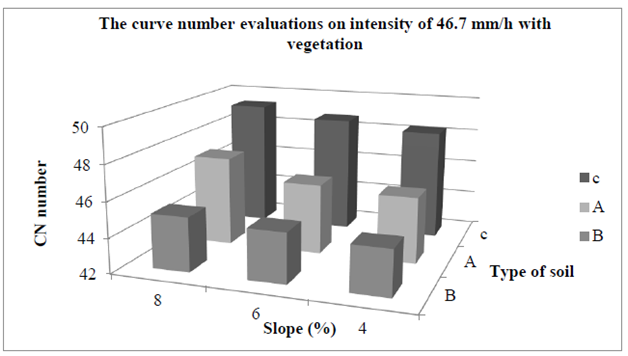
Figure 3 The variation of curve number evaluations base on slope and type of soil at 29.5mm/h stable precipitation with vegetation.

Figure 4 The variation of curve number evaluations base on slope and type of soil at 35 mm/h stable precipitation without vegetation.

Figure 5 The variation of curve number evaluations base on slope and type of soil at 35 mm/h stable precipitation with vegetation.
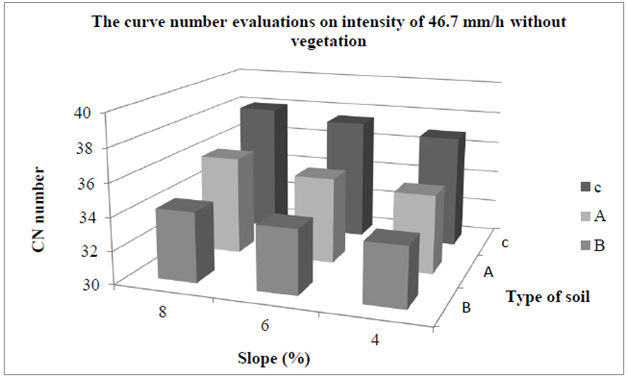
Figure 6 The variation of curve number evaluations base on slope and type of soil at 46.7 mm/h stable precipitation without vegetation.
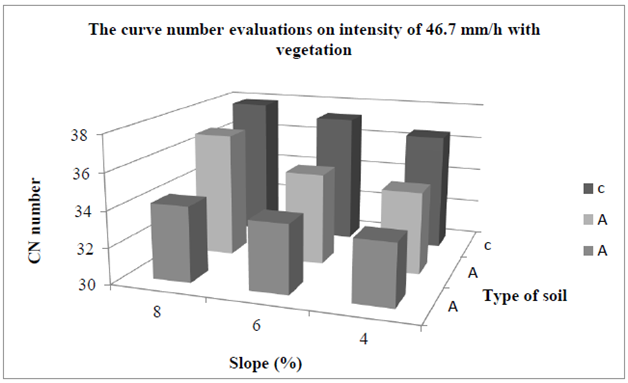
Figure 7 The variation of curve number evaluations base on slope and type of soil at 46.7 mm/h stable precipitation with vegetation.
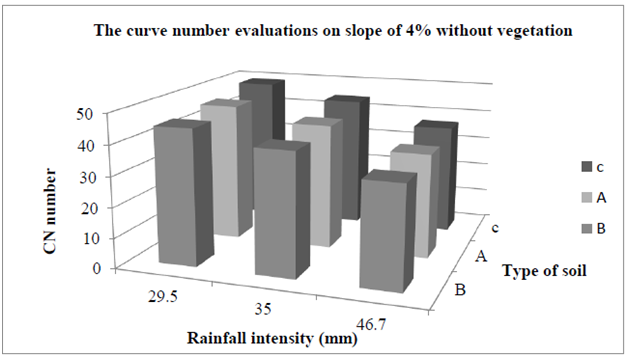
Figure 8 The variation of curve number evaluations base on rainfall intensity and type of soil on stable slope of 4% without vegetation.

Figure 9 The variation of curve number evaluations base on rainfall intensity and type of soil on stable slope of 4% with vegetation.
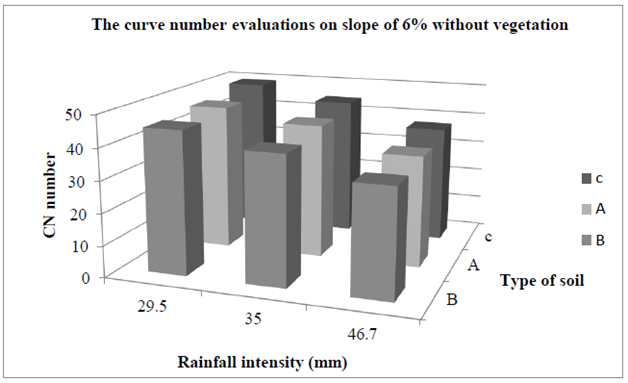
Figure 10 The variation of curve number evaluations base on rainfall intensity and type of soil on stable slope of 6% without vegetation.
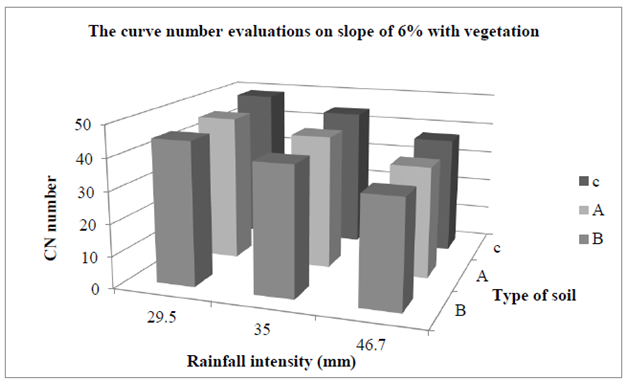
Figure 11 The variation of curve number evaluations base on rainfall intensity and type of soil on stable slope of 6% with vegetation.
Figure 12 & 13 indicate the curve number evaluations changes on slope of 8% for different intensity (29.5, 35, 46.7) for various type of soil (A, B, C) at two state (with and without vegetation). According to the results of diagrams in specific rainfall intensity and for stable slope, changes on grading don’t have significant impact on CN evaluations. But at same gradation with increasing at the rainfall intensity, CN evaluations reduced considerably. According to the achieved results of curve number evaluations in different experiment have been obtained two terms for CN evaluations with and without vegetation.
1) With vegetation
2) Without vegetation
The above parameters are:
According to results outcomes following conclusions have been achieved:
None.
The authors declare that there is no conflict of interest.

©2019 Boudaghpour, et al. This is an open access article distributed under the terms of the, which permits unrestricted use, distribution, and build upon your work non-commercially.